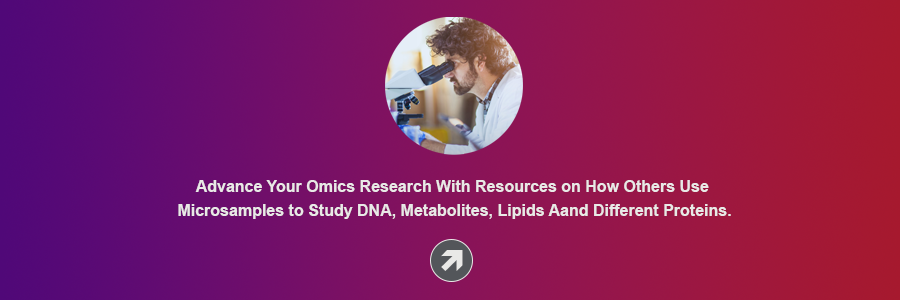Share this
Unlocking the Secrets of Life: The Importance of Genomic DNA Extraction
by Neoteryx Microsampling on Jan 10, 2019 1:29:00 AM
 Our bodies hold a treasure trove of information within each cell, encoded in our DNA. This genetic blueprint, called genomic DNA (gDNA), is found in our chromosomes and carries the instructions for building and maintaining an entire organism. Scientists are fascinated by how these instructions work together, and to unlock these secrets, they need a first step: extracting the gDNA.
Our bodies hold a treasure trove of information within each cell, encoded in our DNA. This genetic blueprint, called genomic DNA (gDNA), is found in our chromosomes and carries the instructions for building and maintaining an entire organism. Scientists are fascinated by how these instructions work together, and to unlock these secrets, they need a first step: extracting the gDNA.
Why is gDNA Extraction Important?
Think of gDNA extraction as collecting the recipe book from your cells. By studying this recipe book, scientists can:
- Understand how our bodies work: They can see how genes interact to control growth, development, and overall health.
- Diagnose diseases: By analyzing variations in gDNA, scientists can identify genetic disorders and develop personalized treatments.
- Aid in forensics: DNA analysis from crime scenes helps identify suspects and solve crimes.
Extracting the Recipe Book: Traditional vs. Modern Methods
Just like retrieving a specific recipe from a book, isolating gDNA requires careful procedures. Traditionally, scientists used methods like phenol extraction. This method involves separating water and a phenol solution (phenol is a chemical) – imagine separating oil and water salad dressing! Proteins get trapped in the oily layer, while gDNA stays in the water. However, this method is:
- Time-consuming: It takes longer compared to modern methods.
- Potentially hazardous: Phenol is toxic and requires careful handling.
Modern methods, like the non-enzymatic salted-out method or the microsphere method, are:
- Faster and cheaper: They save time and resources.
- Safer: They avoid hazardous chemicals.
- More efficient: They extract higher quality and quantity of gDNA.
The Future of Tiny Samples: Blood Microsampling
Just like getting a lot of information from a small recipe book, scientists are now exploring ways to extract gDNA from tiny blood samples. This technique, called blood microsampling, allows for:
- Less invasive procedures: Smaller blood draws are more comfortable for patients.
- Analysis of rare samples: This is useful for studying diseases present in very low quantities.
By using these advanced techniques, scientists can unlock the secrets hidden within our DNA, paving the way for a future of personalized medicine and deeper understanding of life itself.
Share this
- Microsampling (206)
- Research, Remote Research (119)
- Venipuncture Alternative (105)
- Clinical Trials, Clinical Research (83)
- Mitra® Device (73)
- Therapeutic Drug Monitoring, TDM (51)
- Dried Blood Spot, DBS (39)
- Biomonitoring, Health, Wellness (30)
- Infectious Disease, Vaccines, COVID-19 (24)
- Blood Microsampling, Serology (23)
- Omics, Multi-Omics (21)
- Decentralized Clinical Trial (DCT) (20)
- Specimen Collection (18)
- Toxicology, Doping, Drug/Alcohol Monitoring, PEth (17)
- Skin Microsampling, Microbiopsy (14)
- hemaPEN® Device (13)
- Preclinical Research, Animal Studies (12)
- Pharmaceuticals, Drug Development (9)
- Harpera Device (7)
- Industry News, Microsampling News (5)
- Antibodies, MAbs (3)
- Company Press Release, Product Press Release (3)
- Environmental Toxins, Exposures (1)
- July 2025 (1)
- May 2025 (1)
- April 2025 (2)
- December 2024 (2)
- November 2024 (1)
- October 2024 (3)
- September 2024 (1)
- June 2024 (1)
- May 2024 (1)
- April 2024 (4)
- March 2024 (1)
- February 2024 (2)
- January 2024 (4)
- December 2023 (3)
- November 2023 (3)
- October 2023 (3)
- September 2023 (3)
- July 2023 (3)
- June 2023 (2)
- April 2023 (2)
- March 2023 (2)
- February 2023 (2)
- January 2023 (3)
- December 2022 (2)
- November 2022 (3)
- October 2022 (4)
- September 2022 (3)
- August 2022 (5)
- July 2022 (2)
- June 2022 (2)
- May 2022 (4)
- April 2022 (3)
- March 2022 (3)
- February 2022 (4)
- January 2022 (5)
- December 2021 (3)
- November 2021 (5)
- October 2021 (3)
- September 2021 (3)
- August 2021 (4)
- July 2021 (4)
- June 2021 (4)
- May 2021 (4)
- April 2021 (3)
- March 2021 (5)
- February 2021 (4)
- January 2021 (4)
- December 2020 (3)
- November 2020 (5)
- October 2020 (4)
- September 2020 (3)
- August 2020 (3)
- July 2020 (6)
- June 2020 (4)
- May 2020 (4)
- April 2020 (3)
- March 2020 (6)
- February 2020 (3)
- January 2020 (4)
- December 2019 (5)
- November 2019 (4)
- October 2019 (2)
- September 2019 (4)
- August 2019 (4)
- July 2019 (3)
- June 2019 (7)
- May 2019 (6)
- April 2019 (5)
- March 2019 (6)
- February 2019 (5)
- January 2019 (8)
- December 2018 (3)
- November 2018 (4)
- October 2018 (7)
- September 2018 (6)
- August 2018 (5)
- July 2018 (8)
- June 2018 (6)
- May 2018 (5)
- April 2018 (6)
- March 2018 (4)
- February 2018 (6)
- January 2018 (4)
- December 2017 (2)
- November 2017 (3)
- October 2017 (2)
- September 2017 (4)
- August 2017 (2)
- July 2017 (4)
- June 2017 (5)
- May 2017 (6)
- April 2017 (6)
- March 2017 (5)
- February 2017 (4)
- January 2017 (1)
- July 2016 (3)
- May 2016 (1)
- April 2016 (2)



No Comments Yet
Let us know what you think